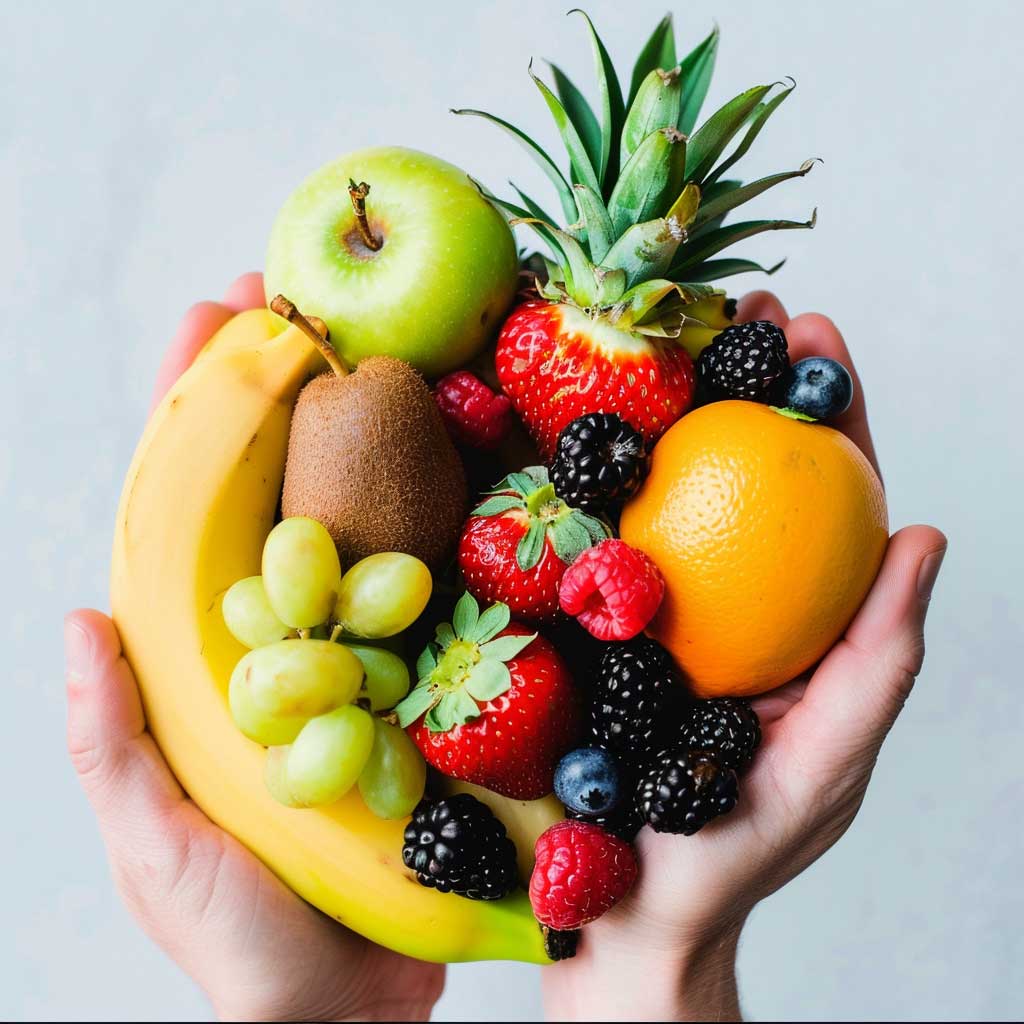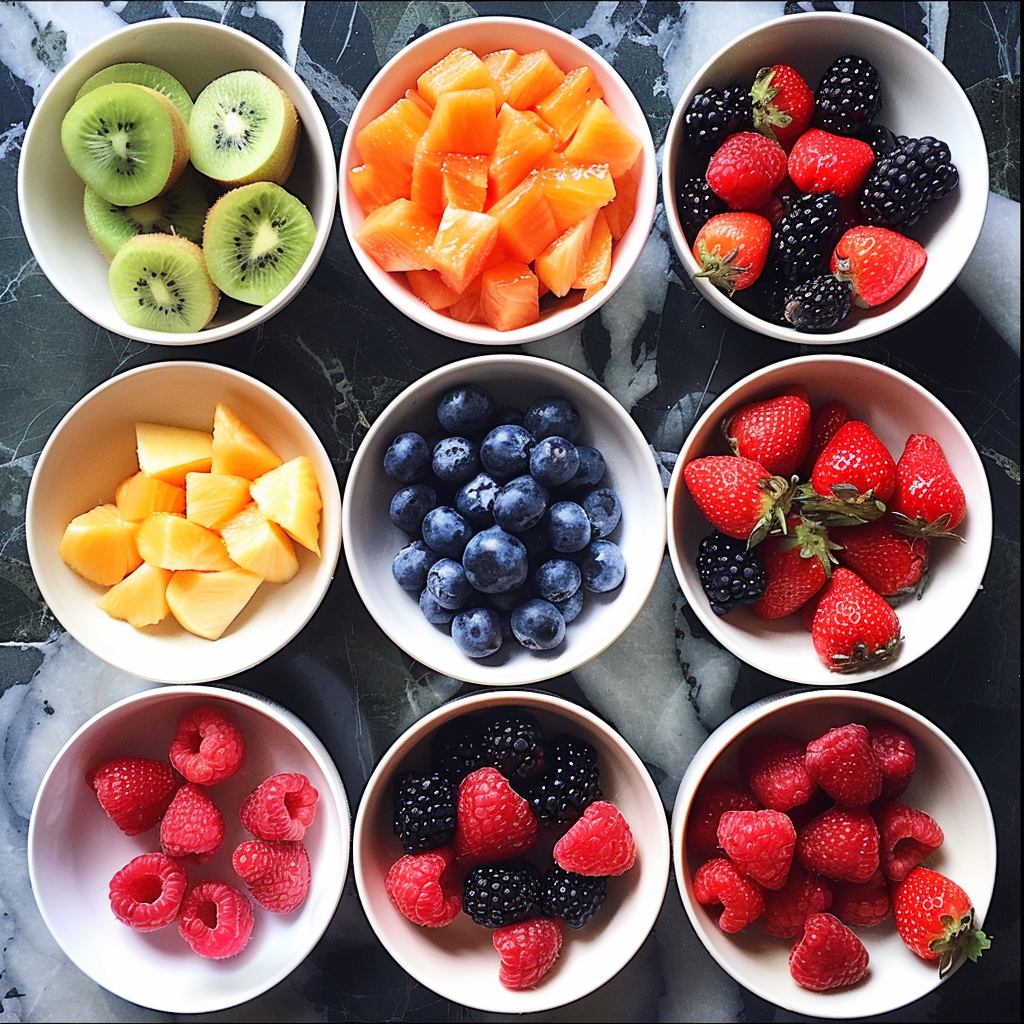Adhering to the Dietary Guidelines for Americans 2015-2020 suggests consuming 2 cups of fruits daily, based on a 2,000-calorie diet. The fruit group comprises whole fruits and 100% fruit juice. Meeting the daily fruit quota can be achieved through various options, such as a small banana, a large orange, or ¼ cup of dried peaches or apricots. Individual needs may vary based on calorie intake. Incorporating a diet abundant in fruits and vegetables as part of a balanced eating pattern may lower the risk of:
- Stroke and cardiovascular diseases.
- Coronary heart disease.
- Type 2 diabetes.
- Certain cancers like those affecting the mouth, stomach, and colon-rectum.
- Kidney stones.
- Bone loss.
Edibles Classified Under the Fruit Group:

Fruits are denoted by the red segment on MyPlate, the USDA’s dietary guideline unveiled in 2011, emphasizing the importance of a balanced diet. Meeting daily fruit requirements is achievable through various forms including fresh, frozen, canned, and dried fruits. While fruit juices lack dietary fiber and may add surplus calories when consumed excessively, it’s advisable that half of the daily fruit intake be sourced from whole fruits.
Frequently Consumed Fruits comprise a wide array: apples, apricots, avocados, bananas, assorted berries (strawberries, blueberries, blackberries, raspberries, cherries), grapefruit, grapes, kiwi, lemons, limes, mangoes, various melons (cantaloupe, honeydew, watermelon), fruit cocktail, nectarines, oranges, peaches, pears, papaya, pineapple, plums, prunes, raisins, and tangerines.
Nutritional Content of Fruits:

Fruits boast abundant dietary fiber and essential nutrients, while being naturally free of cholesterol, low in fats, sodium, and overall calories.
Key Nutrients Found in Fruits:
- Potassium: Aids in maintaining healthy blood pressure levels.
- Dietary fiber: Supports reduced blood cholesterol, lowers the risk of heart disease, promotes proper bowel function (reducing constipation and diverticulosis), and contributes to a sense of fullness with fewer calories.
- Vitamin C: Crucial for tissue growth and repair throughout the body, particularly aiding in wound healing, maintaining oral health, and enhancing iron absorption.
- Folate (folic acid): Essential for red blood cell formation, particularly vital during pregnancy to mitigate the risk of neural tube defects in newborns.
- Phytochemicals: Act as protective agents against diseases, functioning as antioxidants, detoxifiers, immune enhancers, and anti-inflammatories. Inflammation is implicated in conditions like heart disease, certain cancers, allergies, Alzheimer’s, and autoimmune disorders.
Nutrient-Rich Fruits:
Sources of Key Nutrients in Fruits:
Potassium: Found abundantly in bananas, prunes, dried peaches, apricots, pomegranates, cantaloupe, honeydew melon, grapefruits, and oranges, including their juices.
Dietary Fiber: Whole or cut-up fruits with skin intact are rich sources, while fruit juices typically contain minimal fiber content.
Vitamin C: Abundant in pomegranates, guava, kiwi, oranges, grapefruits, strawberries, raspberries, cantaloupe, papaya, pineapple, and mangoes.
Folate (Folic Acid): Prominent sources include oranges and avocados.
Phytochemicals: Notable phytochemicals include anthocyanins (present in blueberries, cherries, blackberries, and raspberries) and quercetin (found in apples). Vibrantly colored fruits and vegetables, such as purple, deep red, bright orange, bright yellow, and dark green varieties, offer a wealth of vitamins, minerals, and antioxidants. Incorporating a diverse array of colors into your daily diet ensures comprehensive nutritional benefits.

Recommended Intake Levels:
Typically, individuals are advised to consume approximately 2 cups of fruits daily. However, the specific quantity required varies based on factors such as age, gender, and activity level. The following recommendations apply to those engaging in less than 30 minutes of moderate physical activity per day, in addition to regular daily tasks. If you lead a more active lifestyle, you may have the flexibility to increase your fruit intake while remaining within your calorie requirements.
Daily Fruit Requirements:

Determining a Cup Portion:
1 cup = 1 cup fruit
1 cup= 1 cup 100% fruit juice
1 cup= ½ cup dried fruit
1 cup= 1 medium-sized piece of fruit
Alternative Portions Equivalent to 1 Cup of Fruit:
- Banana: 1 cup, sliced or 1 large (8″ to 9″ long)
- Cantaloupe: ¼ of a medium melon
- Grapes: 32 seedless grapes
- Peach: 1 large (2¾” diameter) or 2 halves (canned)
- Plums: 3 medium or 2 large plums
- Raisins: 2 small boxes (1.5 oz. each)
- Strawberries: about 8 large berries
- Watermelon: 1 small wedge (1″ thick)
Simple Methods for Incorporating Fruits into Your Diet:
Simple Ways to Increase Your Fruit Intake:
- Keep a bowl of fresh, whole fruit easily accessible on the counter, table, or in the refrigerator.
- Enhance breakfast cereal with sliced bananas, peaches, or berries. Likewise, top waffles and pancakes with fruit. Fresh fruit paired with low-fat or fat-free yogurt is another tasty option.
- Incorporate chopped or mashed fruits into muffins, quick bread, and other baked goods.
- Opt for fruit selections from a salad bar during lunchtime. If preparing your own lunch, include a daily fruit item such as applesauce, a banana, orange, or grapes.
- Serve fresh fruit salads regularly, ensuring to include acidic fruits like pineapple, oranges, or lemon juice to prevent browning of apples, bananas, and pears.
- Prepare fruit kabobs as an alternative to fruit salad, particularly delightful with barbecue meals featuring pineapple and peaches.
- Keep a stock of dried, frozen, and canned fruit, along with pre-cut packages of fruit pieces, like pineapple and melon chunks, for convenient and healthy snacking options.
- Dried fruit makes an excellent portable snack to carry in a purse or backpack, with ¼ cup dried fruit equivalent to ½ cup fresh fruit.
- Enjoy 100% fruit juice as a refreshing beverage option.
- Experiment with new fruit combinations for dinner, such as adding mandarin oranges, grapes, or dried cherries to salads, or incorporating crushed pineapple into coleslaw.
- Vary the texture of fruits consumed to add interest to meals and snacks, alternating between juicy oranges, crunchy apples, and creamy bananas.
- Opt for baked apples, pears, or fruit salads as dessert alternatives to cakes, pies, or cookies.
Fruit Guidelines for Kids:

- Lead by example by incorporating fruit into your own daily meals and snacks.
- Get creative with breakfast by making smiley faces on cereal bowls using sliced bananas for eyes, raisins for a nose, and orange slices for a mouth, or by adding a sprinkle of berries.
- Involve children in kitchen activities like shopping for, cleaning, peeling, or cutting up fruits, based on their age and ability.
- Allow children to choose a new fruit to try during grocery shopping trips.
- Offer cut-up fruits for snacks and desserts.
- Create nutritious snacks like apple slices with peanut butter or frozen yogurt topped with berries.
- Let kids dip strawberries and melon slices into low-fat pudding or yogurt.
- Freeze banana chunks for a convenient snack or dessert option.
- Make frozen treats by freezing 100% fruit juice in ice cube trays or small paper cups, inserting wooden sticks just before the juice hardens.
- Blend fresh or frozen fruit with fat-free or low-fat milk or yogurt to prepare delicious fruit smoothies for children.
- Garnish children’s plates with fruit slices for added appeal.
- Include a juice box containing 100% juice in their lunch box instead of sugar-sweetened drinks or sodas.
- Opt for fruit options like sliced apples, mixed fruit cups, or 100% fruit juice at fast food restaurants.
- Choose dried fruits and 100% fruit juice over candy and fruit-flavored snacks, which typically contain minimal actual fruit content.
- Create fruit kabobs using pineapple chunks, bananas, grapes, and berries for a fun and healthy snack option.
Nutritional Insights:
- Fruits differ in nutrient content, so vary your fruit choices every day.
- Choose canned fruit that is packed in 100% fruit juice or water rather than syrup.
- Make gelatin by substituting 100% fruit juice for the cold water.
- Choose 100% fruit juice rather than fruit drinks that have sugar added and contain very little fruit juice.
- Some fruit juices, such as grape and apple, have little natural vitamin content. Check labels for brands that have been “enriched with vitamin C.”
- Frozen juice bars (100% juice) are healthy alternatives to high-fat snacks.
- For a morning business meeting, replace the donuts with cut-up fresh fruit and a yogurt dip, or offer a variety of fresh whole fruits.
- Check out the restaurants close to work and choose those that offer a good variety of fruits and vegetables on their menu.
- On a long commute, pack fresh fruit, cut-up vegetables, string cheese sticks, or a handful of unsalted nuts so that you won’t be tempted to eat a quick, less healthy snack.
- Select fruits with more potassium often—bananas, prunes and prune juice, honeydew melon, cantaloupe, dried peaches and apricots, orange and pomegranate juice.
- Applesauce is a fat-free substitute for some of the oil when baking a cake.
Ripening Fruits:
Apricots, bananas, cantaloupe, kiwi, mangoes, nectarines, peaches, pears, and plums continue to ripen at room temperature post-harvest. To expedite ripening, place them in a loosely closed brown paper bag or a specialized ripening bowl at room temperature. Ripening bowls are available at various stores specializing in home kitchen supplies. (Note: Plastic bags are not suitable for this purpose.)
Some fruits, once picked, do not further ripen. Purchase or harvest the following fruits when fully ripened and ready-to-eat: apples, cherries, grapes, grapefruit, oranges, pineapple, strawberries, tangerines, and watermelon. Once fully ripened, fruits can be stored in the refrigerator to prolong their shelf life. While refrigerated bananas may develop dark brown skins, their interior will remain light-colored.
Freshly Cut Produce Updates:
New Preservation Techniques for Pre-cut Fruits:
Researchers at the USDA have devised methods to extend the shelf life of pre-cut fruits found in grocery stores. One suggestion involves storing cut fruit in cool water, changing the water every few days. Additionally, increasing the fruit’s acidity by adding lemon juice or other additives can enhance its longevity. Placing cut fruits in an airtight container with a paper towel is another effective strategy, as the towel absorbs moisture, preventing it from reaching the fruit. Freezing and cooking are also proven techniques for preserving pre-cut fruits.
Originally published on 09/05
If you have further inquiries, please contact HGIC at hgic@clemson.edu or 1-888-656-9988.
Original Content Contributors:
Janis G. Hunter, Retired HGIC Nutrition Specialist, Clemson University
Katherine L. Cason, PhD, Former Professor, State Program Leader for Food Safety and Nutrition, Clemson University.
Edited by:
Brianna Weir, Student of Food, Nutrition, and Packaging Science & Former Intern at HGIC, Clemson Extension, Clemson University
This information is provided with the understanding that no discrimination is intended, and the Clemson University Cooperative Extension Service does not endorse any specific brand names or registered trademarks. Additionally, the omission of certain products or manufacturers does not imply discrimination. All recommendations are tailored for South Carolina conditions and may not be suitable for other regions. Pesticides should be used strictly according to the directions on the label. All pesticide recommendations are specific to South Carolina and were legally permissible at the time of publication. However, please note that registration status and application guidelines may change as per the regulations of state and federal authorities. It is crucial to carefully follow all listed directions, precautions, and restrictions.







